The Parc del Laberint d'Horta is an emerald in the ring road surrounding Barcelona. Named for the labyrinth of clipped cypress at its center, the garden is situated north of the city just off the Carrer dels Germans Desvalls, one of several streets in the area named for the Desvalls family who owned the property and built the garden. It is the oldest and perhaps loveliest garden in Barcelona. Contrary to popular (i.e. non-Spanish speaking) belief, 'Horta' has nothing to do with horticulture, it's simply part of the name of the district in which the garden is located.
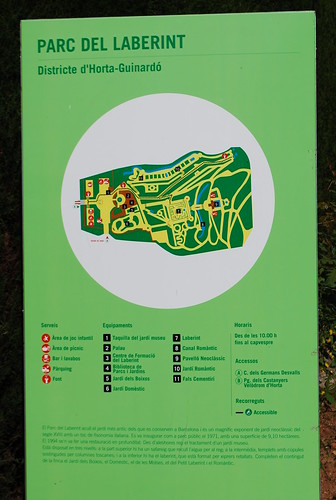
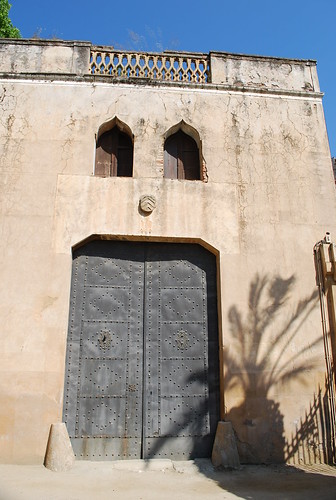
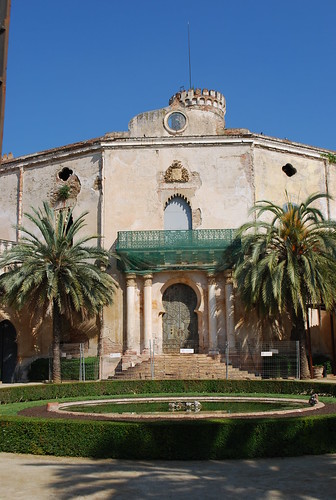
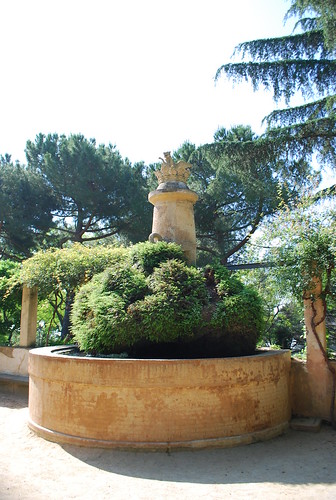 What makes this garden so wonderful is not only the 750 person per day visitor limit but the use of terraces, vistas, and garden rooms that give you the feeling of being in several gardens, not just one. Water is used to effect to draw you from one room to the next, first running along then inviting you to pause and reflect by one of the many still pools. There are ample places for one to sit and enjoy the cool green shade, which I did a lot of since it was hot the day we visited!
What makes this garden so wonderful is not only the 750 person per day visitor limit but the use of terraces, vistas, and garden rooms that give you the feeling of being in several gardens, not just one. Water is used to effect to draw you from one room to the next, first running along then inviting you to pause and reflect by one of the many still pools. There are ample places for one to sit and enjoy the cool green shade, which I did a lot of since it was hot the day we visited!

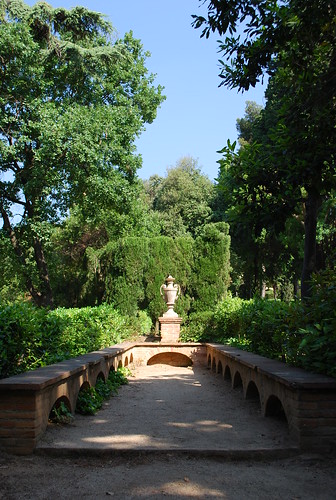 The neoclassical elements in the garden made me wish I had paid more attention in my college Greek and Roman mythology class. Statues and busts of Greek mythical figures decorated the garden rooms, giving one who knows how to 'read' the garden a clue to its overarching theme: love and death. I find with many of the classic tragic love stories that one or other of the lovers usually ends up losing thier head over their amour. This guy was obviously no exception.
The neoclassical elements in the garden made me wish I had paid more attention in my college Greek and Roman mythology class. Statues and busts of Greek mythical figures decorated the garden rooms, giving one who knows how to 'read' the garden a clue to its overarching theme: love and death. I find with many of the classic tragic love stories that one or other of the lovers usually ends up losing thier head over their amour. This guy was obviously no exception.
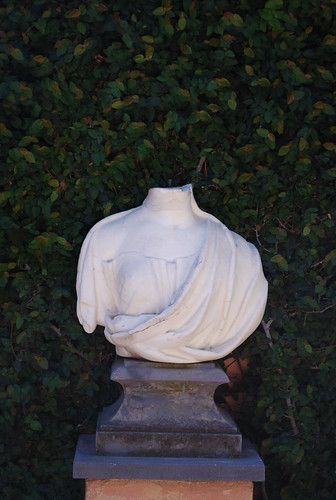
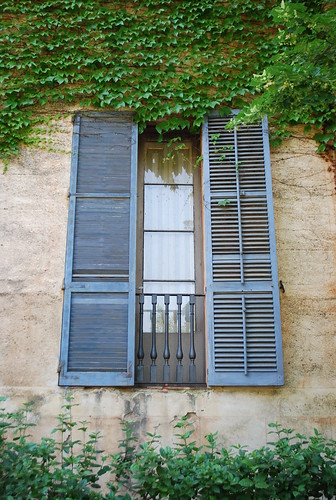

The garden is a mix of 18th century neoclassical and 19th century romantic, begun in 1791 and continued by Desvalls ancestors until the family gave the park to the city of Barcelona in 1969. The Desvalls palace, once the center of social and cultural events as well as open air theatre performances and now home to a school of horticulture, still stands at the entrance to the gardens with its imposing iron studded doors and 16th century watch tower.


Just inside the entrance is this fountain, which we have affectionately dubbed "the poop fountain" owing to an unfortunate meeting between one of my classmates and a bird!
 What makes this garden so wonderful is not only the 750 person per day visitor limit but the use of terraces, vistas, and garden rooms that give you the feeling of being in several gardens, not just one. Water is used to effect to draw you from one room to the next, first running along then inviting you to pause and reflect by one of the many still pools. There are ample places for one to sit and enjoy the cool green shade, which I did a lot of since it was hot the day we visited!
What makes this garden so wonderful is not only the 750 person per day visitor limit but the use of terraces, vistas, and garden rooms that give you the feeling of being in several gardens, not just one. Water is used to effect to draw you from one room to the next, first running along then inviting you to pause and reflect by one of the many still pools. There are ample places for one to sit and enjoy the cool green shade, which I did a lot of since it was hot the day we visited! 
 The neoclassical elements in the garden made me wish I had paid more attention in my college Greek and Roman mythology class. Statues and busts of Greek mythical figures decorated the garden rooms, giving one who knows how to 'read' the garden a clue to its overarching theme: love and death. I find with many of the classic tragic love stories that one or other of the lovers usually ends up losing thier head over their amour. This guy was obviously no exception.
The neoclassical elements in the garden made me wish I had paid more attention in my college Greek and Roman mythology class. Statues and busts of Greek mythical figures decorated the garden rooms, giving one who knows how to 'read' the garden a clue to its overarching theme: love and death. I find with many of the classic tragic love stories that one or other of the lovers usually ends up losing thier head over their amour. This guy was obviously no exception.
Unlike me, you, literate garden reader, are no doubt versed in the story of Theseus and Ariadne and their relationship to the labyrinth (their love story ended with a tragic case of amnesia - what's up with that!?). The labyrinth at Parc del Laberint thankfully doesn't house a minotaur ready to devour you, but if you're brave enough to enter it (I wasn't) you will find a statue of the god Eros at the center. Mercifully, you don't need a string to find your way out, either!
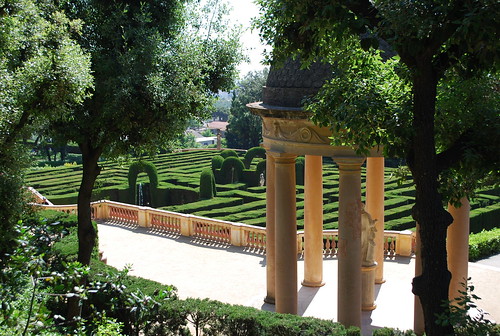

 On the terrace above the labyrinth is a neoclassic pavilion with a reflecting pool and fountain reached by crossing a bridge over the Romantic Canal, at the end of which is the Island of Love. A sculpture of Egeria, a mythological water nymph, overlooks the pool.
On the terrace above the labyrinth is a neoclassic pavilion with a reflecting pool and fountain reached by crossing a bridge over the Romantic Canal, at the end of which is the Island of Love. A sculpture of Egeria, a mythological water nymph, overlooks the pool.
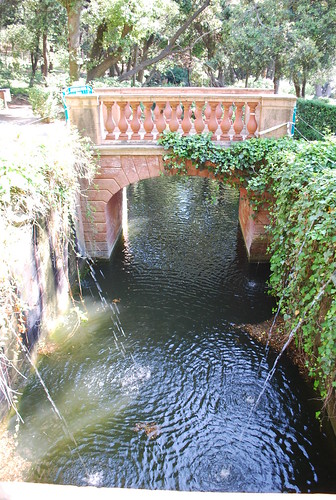
 The newer Jardi Romantic lies on the lowest terrace and is shaded by tall pines and Eucalyptus. The beds are divided in to myrtle-lined rectangles covered in Agapanthus (one common name for it is Flower of Love). When in bloom, I imagine the area would look like a gently waving sea of blossom! Oddly enough, this garden terminates in what used to be called the "false cemetery" which was outfitted with ornamental headstones (no longer there - gee, I wonder why?). This part of the garden does have a more tranquil feeling than the rooms of the upper terraces, and I was drawn to it by the sound of rushing water which I found to be a waterfall and channel that ran the length of the garden. In the center was another quiet pool with a long stone bench echoing the arch of the pool on one side.
The newer Jardi Romantic lies on the lowest terrace and is shaded by tall pines and Eucalyptus. The beds are divided in to myrtle-lined rectangles covered in Agapanthus (one common name for it is Flower of Love). When in bloom, I imagine the area would look like a gently waving sea of blossom! Oddly enough, this garden terminates in what used to be called the "false cemetery" which was outfitted with ornamental headstones (no longer there - gee, I wonder why?). This part of the garden does have a more tranquil feeling than the rooms of the upper terraces, and I was drawn to it by the sound of rushing water which I found to be a waterfall and channel that ran the length of the garden. In the center was another quiet pool with a long stone bench echoing the arch of the pool on one side.
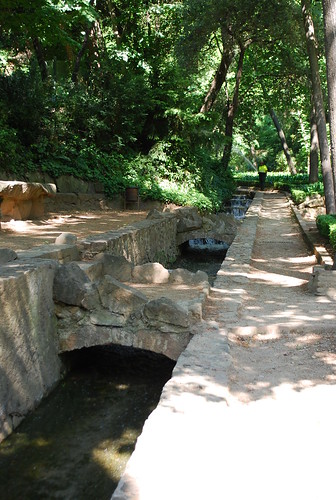
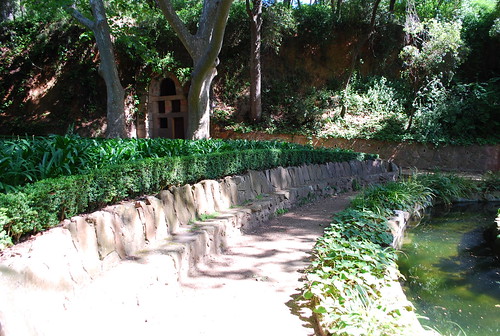
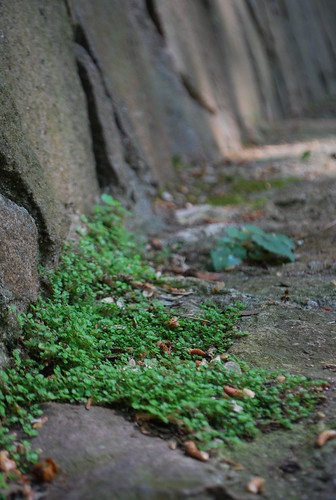
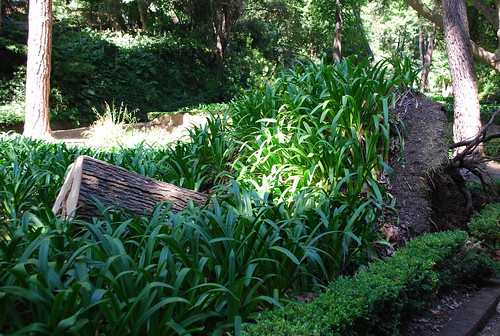

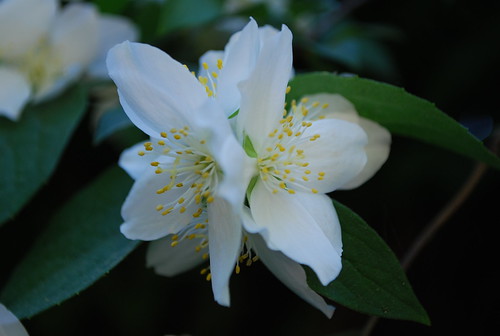
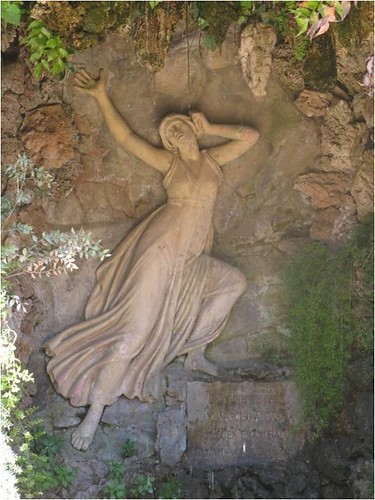 For most of us, this was the favorite garden in Barcelona. When next you're in the area, make a point of visiting. Take along a book of Greek Myths to enjoy while listening to the sound of water playing over the stones, or spend the day with your sweetheart and write a new chapter in your own love story here. Whatever your reason for visiting, Parc del Laberint should be on every garden lover's list when in Barcelona!
For most of us, this was the favorite garden in Barcelona. When next you're in the area, make a point of visiting. Take along a book of Greek Myths to enjoy while listening to the sound of water playing over the stones, or spend the day with your sweetheart and write a new chapter in your own love story here. Whatever your reason for visiting, Parc del Laberint should be on every garden lover's list when in Barcelona!


 On the terrace above the labyrinth is a neoclassic pavilion with a reflecting pool and fountain reached by crossing a bridge over the Romantic Canal, at the end of which is the Island of Love. A sculpture of Egeria, a mythological water nymph, overlooks the pool.
On the terrace above the labyrinth is a neoclassic pavilion with a reflecting pool and fountain reached by crossing a bridge over the Romantic Canal, at the end of which is the Island of Love. A sculpture of Egeria, a mythological water nymph, overlooks the pool.
 The newer Jardi Romantic lies on the lowest terrace and is shaded by tall pines and Eucalyptus. The beds are divided in to myrtle-lined rectangles covered in Agapanthus (one common name for it is Flower of Love). When in bloom, I imagine the area would look like a gently waving sea of blossom! Oddly enough, this garden terminates in what used to be called the "false cemetery" which was outfitted with ornamental headstones (no longer there - gee, I wonder why?). This part of the garden does have a more tranquil feeling than the rooms of the upper terraces, and I was drawn to it by the sound of rushing water which I found to be a waterfall and channel that ran the length of the garden. In the center was another quiet pool with a long stone bench echoing the arch of the pool on one side.
The newer Jardi Romantic lies on the lowest terrace and is shaded by tall pines and Eucalyptus. The beds are divided in to myrtle-lined rectangles covered in Agapanthus (one common name for it is Flower of Love). When in bloom, I imagine the area would look like a gently waving sea of blossom! Oddly enough, this garden terminates in what used to be called the "false cemetery" which was outfitted with ornamental headstones (no longer there - gee, I wonder why?). This part of the garden does have a more tranquil feeling than the rooms of the upper terraces, and I was drawn to it by the sound of rushing water which I found to be a waterfall and channel that ran the length of the garden. In the center was another quiet pool with a long stone bench echoing the arch of the pool on one side.


A recent storm toppled this pine, taking the Agapanthus planted around the base of the tree for a ride.

Leaving the Romantic Garden you come to a quirky little garden with a hermit's hut built into the wall. More seating lines the stone wall and a table and stools cut from tree trunks sits invitingly in the center of the patio. I thought it would have been a very pleasant place to sit and take tea with a faun!

The plantings in the garden are decidedly Mediterranean, with Arbutus unedo, Agapanthus, Eucalyptus, Acanthus, Hedera, and Bougainvillea.
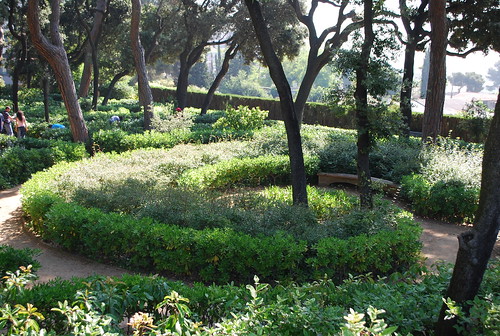




For a place to linger and enjoy a good book, Parc del Laberint offers many secluded nooks where one can sit and revel in the quiet solitude. For the more daring, the labyrinth offers a challenge to the intellect and one's sense of direction. For the garden literate it tells a number of stories, from the many ancient myths depicted in statuary to the repeated theme of love told by the plants and flowers in each of the gardens.
 For most of us, this was the favorite garden in Barcelona. When next you're in the area, make a point of visiting. Take along a book of Greek Myths to enjoy while listening to the sound of water playing over the stones, or spend the day with your sweetheart and write a new chapter in your own love story here. Whatever your reason for visiting, Parc del Laberint should be on every garden lover's list when in Barcelona!
For most of us, this was the favorite garden in Barcelona. When next you're in the area, make a point of visiting. Take along a book of Greek Myths to enjoy while listening to the sound of water playing over the stones, or spend the day with your sweetheart and write a new chapter in your own love story here. Whatever your reason for visiting, Parc del Laberint should be on every garden lover's list when in Barcelona!




1 comment:
Stunning. It's on my future list!
Post a Comment